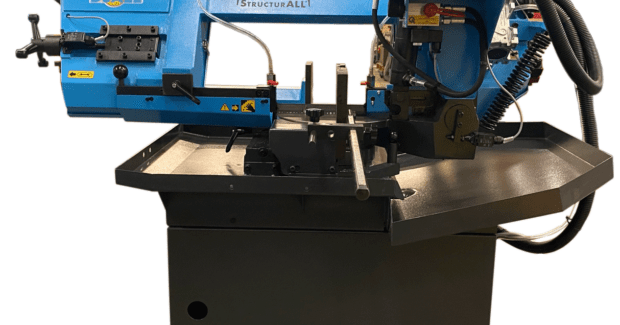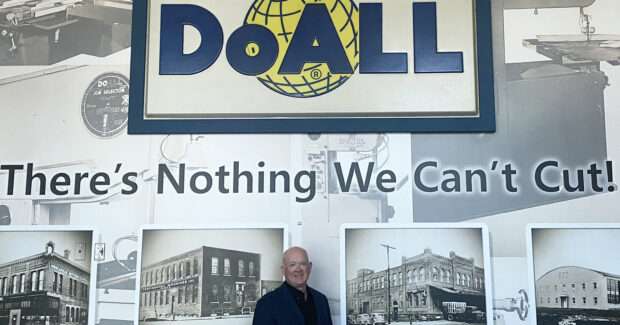DoALL Sawing Products Continues to Prove: “There’s Nothing We Can’t Cut”
DoALL Sawing Products provides the industry’s most comprehensive inventory of metal-cutting products. With its long history of metal-cutting expertise, the company continues as a leader in band saw innovations.
Posted: November 7, 2023
SUPPLIER PROFILE (.pdf)
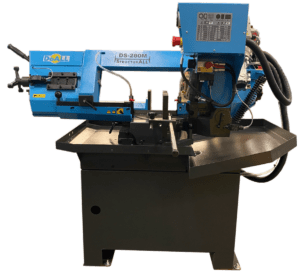
Every day, DoALL Sawing Products (Savage, MN) demonstrates that the entrepreneurial and innovative spirit at work during its founding in 1927 is alive and well. The innovative spirit runs through the company’s DNA, said Steve Yulga, director of sales and marketing for DoALL Sawing Products.
For founder Leighton Wilkie there was a missing component in the metal-cutting industry, which lacked a product to cut metal to length accurately and in a timely manner. While working at his father’s manufacturing company, Wilkie was unable to find a product to suit these requirements. He set out on his own to explore and test solutions to overcome this challenge. In 1933, Wilkie invented the first metal cutting band saw system. The band saw machine and blade could withstand the forces and torque required to powerfully cut metal accurately to specifications.
Today, DoALL Sawing Products’ lineup of band saws and cold saws (circular saws) covers four aspects of sawing: machines, blades, coolants and service. The company also develops custom machinery and offers:
- A full parts department.
- Preventative maintenance and repair services.
- The DoALL University.
- Financing, and many other support services.
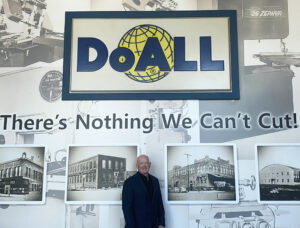
The company’s offerings have never been broader or wider in terms of its lineup, which allows the company to supply a variety of customer types. “Pretty much if you are going to cut an industrial type of material in the world today, we have the machine and tools to cut it,” Yulga said. “We get real vertical with our sophisticated control technology. We have a wide breadth of machines and depth through our expertise in cutting, and our controls.”
Yulga said that DoALL Sawing Products control systems integrate with other manufacturers equipment; for instance, the Dual Column Dual Swivel (DCDS) 750 CNC integrates with an ABB robot. The robot takes a cut piece to an engraving machine and stacks the final part. “We did that a number of years ago and we have refined it to the point where now we have an optional package that our end users can purchase,” Yulga said. The scenarios are limited only by a customer’s imagination.
The next integration of the company’s control will launch in the first quarter of 2024 with a software package that will allow DoALL Sawing Products’ machines to take the dimensions from AutoCAD or SOLIDWORKS CAD software programs to create cut programs for the machine without operator interference. “The whole reason we do what we do with our control technology and our Hercules and our DCDS series is to take as much of the operation out of operators hands to allow them to go out and perform other tasks,” Yulga added.
DoALL Sawing Products ensures it products are designed to assist customers in increasing profitability and efficiencies with less labor, particularly as they continue to face ongoing labor challenges.
Continuous Product Development
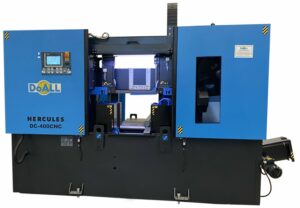
For the team at DoALL Sawing Products, determining a customer’s pain points is the first question they explore: what is working and what isn’t? From there, the company looks at what it has in the toolbox to help customers become more efficient and profitable, with less stress. “We continue to innovate,” Yulga said, “and we continue to listen to our customers and build machines, and blades and coolants that solve issues that our customers come across.” If DoALL Sawing Products is unable to provide the correct solution to these pain points, the company will move customers in the right direction to someone who can assist, Yulga added.
Among recent developments to its products and technologies, the company’s 400S StructurALL Band Saw, which is a longstanding 10”-by-16” fabrication and maintenance shop saw, has been upgraded with a variable frequency drive on the motor, which results in infinite band speeds. The former control was a pendant with an umbilical power cord; the upgraded control attaches to the machine. “It is a more compact footprint, easier for the operator to control,” Yulga said. “It is an improvement on a tried and true machine, and well received by our customers.”
The company’s Hercules band saw lineup features new sizes: the Hercules DC-440 CNC is a 17” saw; the Hercules DC-540 CNC is a 22” saw; and the Hercules DC-640 is a 25” saw. Yulga said the machines feature similar construction to other models but now feature a canted head of 7°. “It is still a dual column machine but can now saw and cut tubing and structural material,” he said. “It is more adept at cutting that than the previous 90° straight cut off saw.”
Regarding machine controls, DoALL Sawing Products has added blade saving features within Siemens and Mitsubishi controls. One feature measures the resistance or torque on the drive motor, and it senses whether the blade is laboring or drawing more amperage from the motor. When this happens, it will slow down the feed and speed, ensuring the operator has an accurate and square cut.
The company has also added zone cutting. “There are up to five zones in a piece, which allows operators to set speeds and feeds,” Yulga said. “An operator can choose to increase or decrease speeds and feeds throughout the piece they are cutting based upon the determined settings for a material type and size. As an example, an operator may want to start the process with more speed and pressure at the top of a round where there is less material. Then the operator may want to slow back down to prescribed settings when reaching the center of round; and when coming out of the cut of the round, the operator may want to decrease speed to reduce burrs.
“We have a blade deflection monitor, which will indicate to the control if the blade is being deflected off square, and it will slow down the feed force and the band speed,” Yulga said. This ensures the blade will remain square as it moves through the material. In addition to an accurate and desired cut, it also saves the blade life by 15%-to-20%.
An addition to the DCDS is the new 2-meter indexing table option. The DCDS series of machines swivels in 60° either way, providing the operator with the ability to do many things with the machines. “We have also incorporated the blade life saving features into that model of machine as well,” Yulga said.
Customer-centric Partnerships
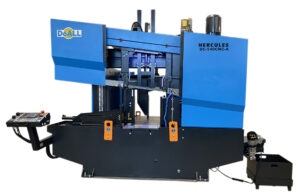
The choice of saw blades is fundamental to the whole experience of partnering with DoALL Sawing Products. The company ensures the right blade is in place for the material being cut. The team develops its solution after determining what a customer wants to accomplish, and what is currently stopping them from achieving those goals. As an example, there are many exotic alloys being used in products such as medical devices and the aerospace industry, Yulga noted. “We start with understanding what the right blade configuration and composition should be,” he said. “Then, we team that with the right machine. We triple that up with the correct cutting fluids to make sure we have the right sawing solution. And we tie it together with a bow for each customer with our customer service.”
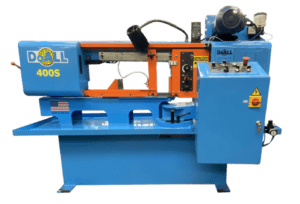
In a recent problem solving measure, DoALL Sawing Products worked with a steel producer and forging house to cut down its production from five days to two hours and 20 minutes, using only one blade in the process.
DoALL custom built a large, 47” machine for the customer, which does work for the U.S. Department of Defense, making gun barrels for U.S. Navy ships. The alloy type was a 4340-ish proprietary recipe. “Through our regional sales manager and his expertise, and utilizing those features outlined above, we were able to cut a 32” round — where the previous week it took the customer five days and three saw blades to get through — with one blade in two hours and 20 minutes,” Yulga said. The DoALL Sawing Products team not only cut through the material faster but also delivered a square product that was within their stated tolerance of ten-thousandths of an inch in terms of length.
Yulga pointed out that DoALL Sawing Products is here for the long haul and isn’t going anywhere, backed by its legacy and the dedication of its employees to build on that legacy of solving cutting issues and problems. Most importantly, Yulga said the DoALL Sawing Products’ team not only provides innovative solutions but also has “fun doing what we do.”
{sidebar}
Leading Factors to Consider When Selecting Saws
Band saw cutting machines provide several advantages such as high-precision cuts on a variety of tough metals and a range of widths. They offer accuracy with less chance of the blade wandering when working on those thicker materials. Consider the following factors when making your choice of sawing application:
- Miter vs. non-miter cuts: If material needs to be cut at any angle other than straight, choose a miter-cutting band saw.
- Individual cuts or nested/bundle cutting: Bundle cutting is good when cutting long bundles into short bundles because it eliminates the need to break and re-strap the bundles.
- Manual vs. semi-automatic vs. automatic: A manual saw requires an operator to manually feed the material, lift the saw head and close the vise. A semi-automatic saw has a hydraulic or pneumatic vise that raises and lowers the saw head but requires an operator to feed the material. An automatic saw needs an operator to program a saw for fully automated material feed (indexing) and cutting.
- Extreme or intermittent duty: In extreme duty production applications (six or more hours per shift or high cutting rates) a heavy-duty saw, wide band, and more horsepower provide greater productivity and reliability.
Other factors to consider include:
- Design capacity vs. effective capacity: A saw is most effective in materials from 1/3 to 2/3 of the rated size capacity. Using a 12″ capacity saw is not ideal for cutting 12″ solids all day.
- Exotic materials vs. mild materials: Hard-to-cut materials, like Inconel and 316 stainless, are best cut with high production, heavy-duty machines and wide blades.
- Budget vs. the right machine: Purchasing a less expensive machine may fall within your budgetary constraints, but not selecting the right machine may result in lost production.
Source: www.doallsaws.com
{sidebar 2}
Variety of Band Saw Blades Available to Suit Your Needs
Your shop’s choice of blades is the foundation for a successful metal-cutting process. Industrial saw blades are available in a range of materials with specific properties to produce desired results. The blade’s teeth do the cutting, and depending on the application, you can choose a blade containing one of the following tooth forms:
- Precision: Provides maximum cutting accuracy and a smooth finish.
- Claw tooth: The best choice for faster cuts or when working with softer materials.
Note that the type of project you are working on will impact the number of teeth on the band saw blade. A blade with more teeth will cut more slowly, but it will yield a smoother finish.
Listed below are a few of DoALL’s top tips for selecting the correct band saw blades for your cutting job:
- Dart Carbon Steel: This blade consists of a high-quality carbon steel material with a rigid back that permits heavy feed and high band tension. This material is less likely to break under extreme pressure, ensuring reliable cutting results and long-lasting performance. Consider this product for vertical band saw machines when cutting mild steels and other non-ferrous materials.
- Penetrator Bi-Metal: This blade is among the best band saw blades for stainless steel and high-production cutting applications. This fast-action blade can reduce cutting times by up to 20% at the same feed force setting, helping keep your projects on schedule. The exceptional wear resistance ensures a longer blade life span and reduces replacement costs.
- Tungsten Carbide: Tungsten carbide is approximately twice as stiff as steel, making these blades an excellent choice for cutting highly abrasive materials. They’re less likely to become dull when working with graphite, aluminum castings and fiberglass.






